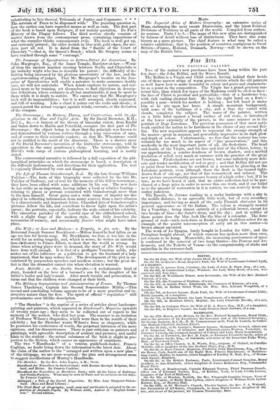lint irto.
THE NATIONAL GALLERY.
Two of the nation's new purchases have been hung within the past few days—the John Bellini, and the Marco Basaiti. The Bellini is a Virgin and Child seated, having behind their heads one of those narrow strips of warm green curtain which the old painters so well knew how to make beautiful in colour and grave and characteris- tic as a point in the composition. The Virgin has a grand gracious ma- ternal face, than which few types of the Madonna could be cited as finer : the face of Christ is peculiar and portraitlike—that of a handsome boy, with rich curling chestnut hair. He lays his right hand on a fruit— possibly a pear—which his mother is holding ; her left hand is under him as be sits upon her knee. A simple mountain background, with some of the buildings of a city, and a blue sky varied with clouds, completes the subject. The name of the painter, written on a little label against a broad surface of red stone, is introduced at the lower extremity of the picture, in the same manner as in the portrait of Doge Loredano. The previous possession of that most noble work entitled the nation to be fastidious in the choice of any second Bel- lini. The new acquisition appears to represent the average strength of the master—great in manner, and powerfully impressive in its dark glow and depth of colour. Unfortunately, we fear that the restorer has con- tributed far too much to its aspect of "fine preservation," and this markedly in the most important parts of all, the flesh-tints. The head and hands of the Virgin, and the face and hair of the Christ, betray, to our apprehension, a sombre deadness of brown shadow, and a morbid gradation of relief, very much at variance with the practice of the great Venetians. Flesh-shadows are not brown, but some infinitely more deli- cate and tender modification of red or grey ; and that Bellini did not see or paint them brown, may be certified in a moment by glancing at the Loredano portrait, even although there the flesh is the tanned tight- drawn flesh of old age, not that of fair womanhood and infancy. The new picture unquestionably possesses beauty of a high order • but, if it be ' true as we have heard it said, that an entire collection Wad to be pur- chased at a large price in order to secure this one work, and if our belief as to the amount of restoration in it is correct, we can scarcely deem the outlay judicious.
The Basaiti, St. Jerome reading in a rocky landscape with a city in the middle distance, is -an agreeable little work, but of very secondary importance, and having as much of the early Flemish character in its general appearance as of the Italian. The colour is strangely neutral for a Venetian ; being almost entirely of a yellowish brown, except for two breaks of blue—the Saint's dress, and the sky' and in neither of these points does the blue look like the blue of a colourist. The fore- ground of rock—such rock-form as Ruskin might doubtless select for an example of the quaint misconception of early art in this matter—is -brown almost unvtuied.
The work of Lo Spagna, lately bought in London for 620/. and the Peruginos bought abroad, of which rumour has spoken more than once, yet remain to be hung. Meanwhile, the increasing preciousness of space is confessed in the removal of two large Guidos—the Perseus and An- dromeda, and the Toilette of Venus—to the companionship of sticks and umbrellas in the entrance-hall.


























 Previous page
Previous page